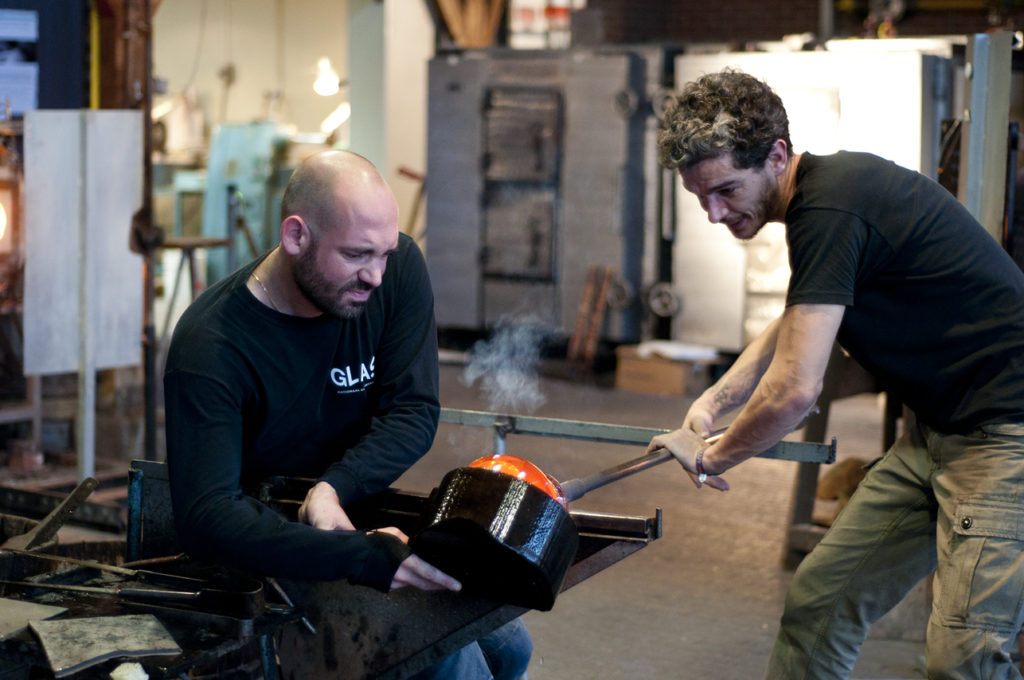 Two pieces from Philipp Weber’s On Colours project, 2014, utilizing a new tool he created: a trumpet-inspired glassblowing pipe. Except as noted, all images Philipp Weber Photos.
Two pieces from Philipp Weber’s On Colours project, 2014, utilizing a new tool he created: a trumpet-inspired glassblowing pipe. Except as noted, all images Philipp Weber Photos.
Design
Glass Compositions
FOR BERLIN-BASED DESIGNER PHILIPP WEBER, it’s all about the human story. His cumulative projects stem from in-depth investigations into family history, lost craft traditions, heavy industry, and performance—earning him the “Newcomer” German Design Award for 2018. Placing material development at the core of his practice, he draws holistic connections between narratives. His results reinterpret, mirror, and extract elements from age-old techniques as a means of reflecting on the disconnection of our digital age. “Only through machines or computers do we now access things,” he claims. “We’re no longer connected to the physical.”

Glassblower Christophe Genard and his assistant working on On Colours.
Weber is also not one to adhere to the culture of “newness”—churning out new work to meet the demands of an increasingly hurried international design fair circuit. “I like to allow time for projects to evolve naturally,” he explains. This approach is exemplified in A Strange Symphony and From Below, two projects that were on view this past spring at the Kunstgewerbemuseum in Berlin, where they were embedded in the museum’s historic glass and silverware collections, respectively.
A Strange Symphony is a multi-faceted project that began in 2013 as Weber’s graduation project at the Design Academy Eindhoven. Observing Belgian glassblower Christophe Genard in action, Weber became intrigued by the blowpipe Genard used. Relatively unchanged for almost two thousand years, this traditional device employs a single air tube that can produce glass vessels with a single chamber, or cavity.

Weber’s glassblowing trumpet and some pieces from his projects A Strange Symphony and On Colours as displayed earlier this year at the Kunstgewerbemuseum in Berlin. Dario J Laganà Photo
Weber was also struck by the similarities between the glassblower’s intense movements and those of a musical instrument player. For him, the blowpipe began to resemble a trumpet. He wanted to see what would happen if additional air tubes and valve mechanisms were added to the device. Working closely with an engineer, he developed a new blowpipe, which was introduced into Genard’s practice. Genard, inspired by the innovations, began to improvise; the surprising outcome was a series of glass vessels with multiple chambers.
Weber then created a film to capture the whole process. Over the next few years, he also produced a series of live performances, held at heritage glassworks throughout Europe. At the National Glass Museum in Leerdam in the Netherlands, for example, he asked a cello player to perform while Genard created forms using the new blowpipe.

Two of five geometrical shapes Weber created in his From Below project, 2017. Dario J Laganà Photo
“The concept behind A Strange Symphony was to give new meaning or value to an almost forgotten craft.” Weber explains. “Part of this was to show that glassblowing is a human process; a dance that reveals one’s relationship with material.” Weber and Genard have continued to experiment, and, in 2014, he produced a collection called On Colours, applying different colors to each cavity of a given vessel to create a slew of variations.
More recently Weber embarked on From Below, his thesis project for his master’s degree at Universität der Künste Berlin, which derived from research into his family’s history in the coal mining industry that once thrived in Germany’s Ruhr region. Analyzing the industrial procedure in which coal is used to forge steel, he chose to home in on the stage in which coal becomes coke—a form of nearly pure carbon that is used to forge iron sinter, one component in a multi-step process that eventually produces steel. Intrigued by the plasticity of coke, he began to experiment with how it could be used to make different types of sculptural objects. Weber spent two years testing out this concept—employing various molds and a bespoke oven. “The challenge was to tame this temperamental material,” he says. After many unsuccessful attempts, he was finally able to calibrate the right formula of temperature, time, and shape to achieve different vessel forms. The results have an almost porcelain-like character.

A look inside Weber’s sketchbook, with ideas for From Below. Dario J Laganà Photo
“After taking a bit of distance from these two projects, I realized that A Strange Symphony gave new life to a craft tradition, while From Below dissected an industrial process using a craft focus,” he reflects. “In my next project, I’m returning to glass, but hope to bridge these two elements.”










